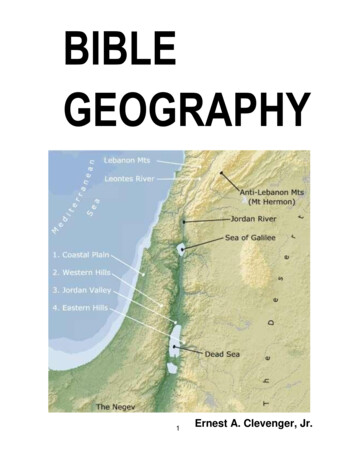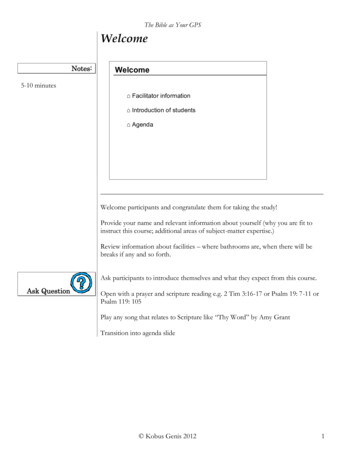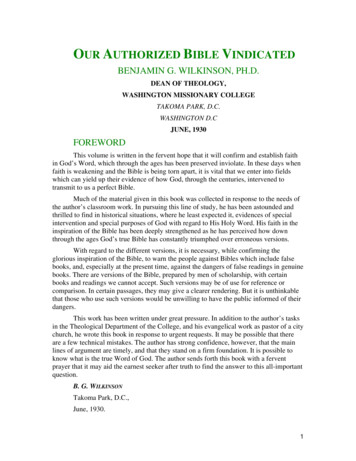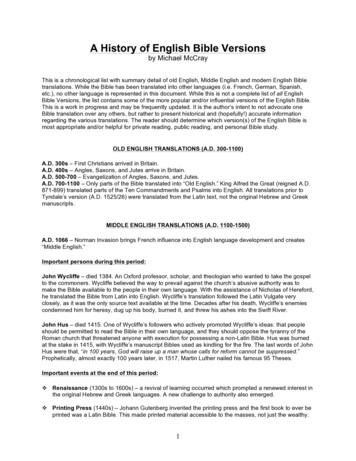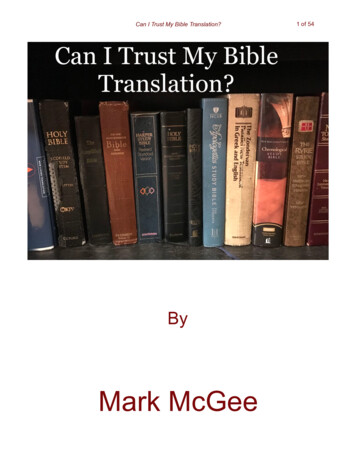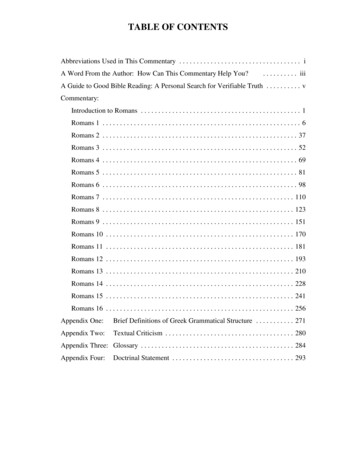
Transcription
TABLE OF CONTENTSAbbreviations Used in This Commentary . . . . . . . . . . . . . . . . . . . . . . . . . . . . . . . . . . . iA Word From the Author: How Can This Commentary Help You?. . . . . . . . . . iiiA Guide to Good Bible Reading: A Personal Search for Verifiable Truth . . . . . . . . . . vCommentary:Introduction to Romans . . . . . . . . . . . . . . . . . . . . . . . . . . . . . . . . . . . . . . . . . . . . . . 1Romans 1 . . . . . . . . . . . . . . . . . . . . . . . . . . . . . . . . . . . . . . . . . . . . . . . . . . . . . . . . . 6Romans 2 . . . . . . . . . . . . . . . . . . . . . . . . . . . . . . . . . . . . . . . . . . . . . . . . . . . . . . . . 37Romans 3 . . . . . . . . . . . . . . . . . . . . . . . . . . . . . . . . . . . . . . . . . . . . . . . . . . . . . . . . 52Romans 4 . . . . . . . . . . . . . . . . . . . . . . . . . . . . . . . . . . . . . . . . . . . . . . . . . . . . . . . . 69Romans 5 . . . . . . . . . . . . . . . . . . . . . . . . . . . . . . . . . . . . . . . . . . . . . . . . . . . . . . . . 81Romans 6 . . . . . . . . . . . . . . . . . . . . . . . . . . . . . . . . . . . . . . . . . . . . . . . . . . . . . . . . 98Romans 7 . . . . . . . . . . . . . . . . . . . . . . . . . . . . . . . . . . . . . . . . . . . . . . . . . . . . . . . 110Romans 8 . . . . . . . . . . . . . . . . . . . . . . . . . . . . . . . . . . . . . . . . . . . . . . . . . . . . . . . 123Romans 9 . . . . . . . . . . . . . . . . . . . . . . . . . . . . . . . . . . . . . . . . . . . . . . . . . . . . . . . 151Romans 10 . . . . . . . . . . . . . . . . . . . . . . . . . . . . . . . . . . . . . . . . . . . . . . . . . . . . . . 170Romans 11 . . . . . . . . . . . . . . . . . . . . . . . . . . . . . . . . . . . . . . . . . . . . . . . . . . . . . . 181Romans 12 . . . . . . . . . . . . . . . . . . . . . . . . . . . . . . . . . . . . . . . . . . . . . . . . . . . . . . 193Romans 13 . . . . . . . . . . . . . . . . . . . . . . . . . . . . . . . . . . . . . . . . . . . . . . . . . . . . . . 210Romans 14 . . . . . . . . . . . . . . . . . . . . . . . . . . . . . . . . . . . . . . . . . . . . . . . . . . . . . . 228Romans 15 . . . . . . . . . . . . . . . . . . . . . . . . . . . . . . . . . . . . . . . . . . . . . . . . . . . . . . 241Romans 16 . . . . . . . . . . . . . . . . . . . . . . . . . . . . . . . . . . . . . . . . . . . . . . . . . . . . . . 256Appendix One:Brief Definitions of Greek Grammatical Structure . . . . . . . . . . . 271Appendix Two:Textual Criticism . . . . . . . . . . . . . . . . . . . . . . . . . . . . . . . . . . . . . 280Appendix Three: Glossary . . . . . . . . . . . . . . . . . . . . . . . . . . . . . . . . . . . . . . . . . . . . 284Appendix Four:Doctrinal Statement . . . . . . . . . . . . . . . . . . . . . . . . . . . . . . . . . . . 293
TABLE OF CONTENTS FOR SPECIAL TOPICS IN ROMANSSend (ApostellÇ), 1:1 . . . . . . . . . . . . . . . . . . . . . . . . . . . . . . . . . . . . . . . . . . . . . . . . 8Kerygma of the Early Church, 1:2 . . . . . . . . . . . . . . . . . . . . . . . . . . . . . . . . . . . . . . 9The Son of God, 1:3 . . . . . . . . . . . . . . . . . . . . . . . . . . . . . . . . . . . . . . . . . . . . . . . . 10Flesh (Sarx), 1:3 . . . . . . . . . . . . . . . . . . . . . . . . . . . . . . . . . . . . . . . . . . . . . . . . . . . 12Names for Deity, 1:4 . . . . . . . . . . . . . . . . . . . . . . . . . . . . . . . . . . . . . . . . . . . . . . . 13Bob’s Evangelical Biases, 1:5 . . . . . . . . . . . . . . . . . . . . . . . . . . . . . . . . . . . . . . . . 17Called. 1:6 . . . . . . . . . . . . . . . . . . . . . . . . . . . . . . . . . . . . . . . . . . . . . . . . . . . . . . 18Saints, 1:6 . . . . . . . . . . . . . . . . . . . . . . . . . . . . . . . . . . . . . . . . . . . . . . . . . . . . . . . . 19Father, 1:7 . . . . . . . . . . . . . . . . . . . . . . . . . . . . . . . . . . . . . . . . . . . . . . . . . . . . . . . 19Righteousness, 1:17 . . . . . . . . . . . . . . . . . . . . . . . . . . . . . . . . . . . . . . . . . . . . . . . . 23“Truth” in Paul’s Writings, 1:18 . . . . . . . . . . . . . . . . . . . . . . . . . . . . . . . . . . . . . . 27Destroy, Ruin, Corrupt (Phtheir‘), 1:23 . . . . . . . . . . . . . . . . . . . . . . . . . . . . . . . . 30The Heart, 1:24 . . . . . . . . . . . . . . . . . . . . . . . . . . . . . . . . . . . . . . . . . . . . . . . . . . . 31Forever (Greek Idioms), 1:25 . . . . . . . . . . . . . . . . . . . . . . . . . . . . . . . . . . . . . . . . . 30Amen, 1:25 . . . . . . . . . . . . . . . . . . . . . . . . . . . . . . . . . . . . . . . . . . . . . . . . . . . . . . . 31Homosexuality, 1:26,27 . . . . . . . . . . . . . . . . . . . . . . . . . . . . . . . . . . . . . . . . . . . . . 33Vices and Virtues in the New Testament, 1:28-31 . . . . . . . . . . . . . . . . . . . . . . . . 34Paul’s Use of Huper Compounds, 1:30 . . . . . . . . . . . . . . . . . . . . . . . . . . . . . . . . . 35Repentance, 2:4 . . . . . . . . . . . . . . . . . . . . . . . . . . . . . . . . . . . . . . . . . . . . . . . . . . . 39Racism, 2:11 . . . . . . . . . . . . . . . . . . . . . . . . . . . . . . . . . . . . . . . . . . . . . . . . . . . . . 42Boasting, 2:17 . . . . . . . . . . . . . . . . . . . . . . . . . . . . . . . . . . . . . . . . . . . . . . . . . . . . 47Greek Terms for “Testing” and their Connotations, 2:18 . . . . . . . . . . . . . . . . . . . 48Null and Void (KatargeÇ), 3:3 . . . . . . . . . . . . . . . . . . . . . . . . . . . . . . . . . . . . . . . . 54Glory, 3:23 . . . . . . . . . . . . . . . . . . . . . . . . . . . . . . . . . . . . . . . . . . . . . . . . . . . . . . . 61NT Evidence of One’s Salvation, 3:24 . . . . . . . . . . . . . . . . . . . . . . . . . . . . . . . . . 62Ransom/Redeem, 3:24 . . . . . . . . . . . . . . . . . . . . . . . . . . . . . . . . . . . . . . . . . . . . . . 62Believe/Faith, 4:5 . . . . . . . . . . . . . . . . . . . . . . . . . . . . . . . . . . . . . . . . . . . . . . . . . . 72Seal, 4:11 . . . . . . . . . . . . . . . . . . . . . . . . . . . . . . . . . . . . . . . . . . . . . . . . . . . . . . . . 75Guarantee, 4:16 . . . . . . . . . . . . . . . . . . . . . . . . . . . . . . . . . . . . . . . . . . . . . . . . . . . 78Peace, 5:1 . . . . . . . . . . . . . . . . . . . . . . . . . . . . . . . . . . . . . . . . . . . . . . . . . . . . . . . . 84Stand (Hist‘mi), 5:2 . . . . . . . . . . . . . . . . . . . . . . . . . . . . . . . . . . . . . . . . . . . . . . . . 85
Tribulation, 5:3 . . . . . . . . . . . . . . . . . . . . . . . . . . . . . . . . . . . . . . . . . . . . . . . . . . . 87Reigning in the Kingdom of God, 5:17,18 . . . . . . . . . . . . . . . . . . . . . . . . . . . . . . 94Baptism, 6:3-4 . . . . . . . . . . . . . . . . . . . . . . . . . . . . . . . . . . . . . . . . . . . . . . . . . . . 101Sanctification, 6:4 . . . . . . . . . . . . . . . . . . . . . . . . . . . . . . . . . . . . . . . . . . . . . . . . 102Form (Tupos), 6:17 . . . . . . . . . . . . . . . . . . . . . . . . . . . . . . . . . . . . . . . . . . . . . . . 107Paul’s Praise, Prayer, and Thanksgiving to God, 7:25 . . . . . . . . . . . . . . . . . . . . . 121Jesus and the Spirit, 8:9 . . . . . . . . . . . . . . . . . . . . . . . . . . . . . . . . . . . . . . . . . . . . 129The Trinity, 8:11 . . . . . . . . . . . . . . . . . . . . . . . . . . . . . . . . . . . . . . . . . . . . . . . . . 130Believers’ Inheritance, 8:17 . . . . . . . . . . . . . . . . . . . . . . . . . . . . . . . . . . . . . . . . . 135Natural Resources, 8:19 . . . . . . . . . . . . . . . . . . . . . . . . . . . . . . . . . . . . . . . . . . . . 136Hope, 8:25 . . . . . . . . . . . . . . . . . . . . . . . . . . . . . . . . . . . . . . . . . . . . . . . . . . . . . . 140The Need to Persevere, 8:25 . . . . . . . . . . . . . . . . . . . . . . . . . . . . . . . . . . . . . . . . 141The Personhood of the Spirit, 8:26 . . . . . . . . . . . . . . . . . . . . . . . . . . . . . . . . . . . 142Firstborn, 8:29 . . . . . . . . . . . . . . . . . . . . . . . . . . . . . . . . . . . . . . . . . . . . . . . . . . . 145Election/Predestination and the Need for a Theological Balance, 8:33 . . . . . . . . 146Arch‘, 8:38 . . . . . . . . . . . . . . . . . . . . . . . . . . . . . . . . . . . . . . . . . . . . . . . . . . . . . . 148Intercessory Prayer, 9:3 . . . . . . . . . . . . . . . . . . . . . . . . . . . . . . . . . . . . . . . . . . . . 154Curse (Anathema), 9:3 . . . . . . . . . . . . . . . . . . . . . . . . . . . . . . . . . . . . . . . . . . . . . 157Covenant, 9:4 . . . . . . . . . . . . . . . . . . . . . . . . . . . . . . . . . . . . . . . . . . . . . . . . . . . . 158The Remnant, Three Senses, 9:27-28 . . . . . . . . . . . . . . . . . . . . . . . . . . . . . . . . . 166Cornerstone, 9:33 . . . . . . . . . . . . . . . . . . . . . . . . . . . . . . . . . . . . . . . . . . . . . . . . . 168Submission, 10:3 . . . . . . . . . . . . . . . . . . . . . . . . . . . . . . . . . . . . . . . . . . . . . . . . . 172Greek Verb Tenses Used for Salvation, 10:4 . . . . . . . . . . . . . . . . . . . . . . . . . . . . 173Confession, 10:9 . . . . . . . . . . . . . . . . . . . . . . . . . . . . . . . . . . . . . . . . . . . . . . . . . 175The Name of the Lord, 10:9 . . . . . . . . . . . . . . . . . . . . . . . . . . . . . . . . . . . . . . . . . 176Jesus The Nazarene, 10:13 . . . . . . . . . . . . . . . . . . . . . . . . . . . . . . . . . . . . . . . . . . 177Mystery, 11:25 . . . . . . . . . . . . . . . . . . . . . . . . . . . . . . . . . . . . . . . . . . . . . . . . . . . 189Holy, 12:1 . . . . . . . . . . . . . . . . . . . . . . . . . . . . . . . . . . . . . . . . . . . . . . . . . . . . . . 195This Age and the Age to Come, 12:2 . . . . . . . . . . . . . . . . . . . . . . . . . . . . . . . . . . 196Renew (AnakainÇsis), 12:2 . . . . . . . . . . . . . . . . . . . . . . . . . . . . . . . . . . . . . . . . . 197The Will (Thel‘ma) of God, 12:2 . . . . . . . . . . . . . . . . . . . . . . . . . . . . . . . . . . . . 198New Testament Prophecy, 12:6 . . . . . . . . . . . . . . . . . . . . . . . . . . . . . . . . . . . . . . 200Generous, Sincere (Haplotes), 12:8 . . . . . . . . . . . . . . . . . . . . . . . . . . . . . . . . . . . 203
KoinÇnia, 12:13 . . . . . . . . . . . . . . . . . . . . . . . . . . . . . . . . . . . . . . . . . . . . . . . . . . 206Human Government, 13:1 . . . . . . . . . . . . . . . . . . . . . . . . . . . . . . . . . . . . . . . . . . 212Paul’s Views of Mosaic Law, 13:9 . . . . . . . . . . . . . . . . . . . . . . . . . . . . . . . . . . . 217Notes on Exodus 20,13:15,17 . . . . . . . . . . . . . . . . . . . . . . . . . . . . . . . . . . . . . . . 218Weakness, 14:1 . . . . . . . . . . . . . . . . . . . . . . . . . . . . . . . . . . . . . . . . . . . . . . . . . . 230Should Christians Judge One Another?, 14:13 . . . . . . . . . . . . . . . . . . . . . . . . . . 235The Kingdom of God, 14:17 . . . . . . . . . . . . . . . . . . . . . . . . . . . . . . . . . . . . . . . . 237Edify, 15:2 . . . . . . . . . . . . . . . . . . . . . . . . . . . . . . . . . . . . . . . . . . . . . . . . . . . . . . 243Abound (PerissevÇ), 15:13 . . . . . . . . . . . . . . . . . . . . . . . . . . . . . . . . . . . . . . . . . 247The Christian and the Hungry, 15:26 . . . . . . . . . . . . . . . . . . . . . . . . . . . . . . . . . . 251Women in the Plan of God, 16:1 . . . . . . . . . . . . . . . . . . . . . . . . . . . . . . . . . . . . . 258Church (Ekklesia), 16:1 . . . . . . . . . . . . . . . . . . . . . . . . . . . . . . . . . . . . . . . . . . . . 261Personal Evil, 16:20 . . . . . . . . . . . . . . . . . . . . . . . . . . . . . . . . . . . . . . . . . . . . . . . 266Eternal, 16:26 . . . . . . . . . . . . . . . . . . . . . . . . . . . . . . . . . . . . . . . . . . . . . . . . . . . . 269
ABBREVIATIONS USED IN THIS COMMENTARYABAnchor Bible Commentaries, ed. William Foxwell Albright and David Noel FreedmanABDAnchor Bible Dictionary (6 vols.), ed. David Noel FreedmanAKOTAnalytical Key to the Old Testament by John Joseph OwensANETAncient Near Eastern Texts, James B. PritchardBDBA Hebrew and English Lexicon of the Old Testament by F. Brown, S. R. Driver andC. A. BriggsBHSBiblia Hebraica Stuttgartensia, GBS, 1997IDBThe Interpreter’s Dictionary of the Bible (4 vols.), ed. George A. ButtrickISBEInternational Standard Bible Encyclopedia (5 vols.), ed. James OrrJBJerusalem BibleJPSOAThe Holy Scriptures According to the Masoretic Text: A New Translation (The JewishPublication Society of America)KBThe Hebrew and Aramaic Lexicon of the Old Testament by Ludwig Koehler and WalterBaumgartnerLAMThe Holy Bible From Ancient Eastern Manuscripts (the Peshitta) by George M. LamsaLXXSeptuagint (Greek-English) by Zondervan, 1970MOFA New Translation of the Bible by James MoffattMTMasoretic Hebrew TextNABNew American Bible TextNASBNew American Standard BibleNEBNew English BibleNETNET Bible: New English Translation, Second Beta EditionNIDOTTENew International Dictionary of Old Testament Theology and Exegesis (5 vols.), ed.Willem A. VanGemerenNRSVNew Revised Standard Biblei
NIVNew International VersionNJBNew Jerusalem BibleOTPGOld Testament Parsing Guide by Todd S. Beall, William A. Banks and Colin SmithREBRevised English BibleRSVRevised Standard VersionSEPTThe Septuagint (Greek-English) by Zondervan, 1970TEVToday’s English Version from United Bible SocietiesYLTYoung’s Literal Translation of the Holy Bible by Robert YoungZPBEZondervan Pictorial Bible Encyclopedia (5 vols.), ed. Merrill C. Tenneyii
A WORD FROM THE AUTHOR:HOW CAN THIS COMMENTARY HELP YOU?Biblical interpretation is a rational and spiritual process that attempts to understand an ancient inspiredwriter in such a way that the message from God may be understood and applied in our day.The spiritual process is crucial but difficult to define. It does involve a yieldedness and openness to God.There must be a hunger (1) for Him, (2) to know Him, and (3) to serve Him. This process involves prayer,confession and the willingness for lifestyle change. The Spirit is crucial in the interpretive process, but whysincere, godly Christians understand the Bible differently is a mystery.The rational process is easier to describe. We must be consistent and fair to the text and not beinfluenced by our personal or denominational biases. We are all historically conditioned. None of us areobjective, neutral interpreters. This commentary offers a careful rational process containing threeinterpretive principles structured to help us overcome our biases.First PrincipleThe first principle is to note the historical setting in which a biblical book was written and the particularhistorical occasion for its authorship. The original author had a purpose, a message to communicate. Thetext cannot mean something to us that it never meant to the original, ancient, inspired author. Hisintent—not our historical, emotional, cultural, personal or denominational need—is the key. Applicationis an integral partner to interpretation, but proper interpretation must always precede application. It mustbe reiterated that every biblical text has one and only one meaning. This meaning is what the originalbiblical author intended through the Spirit’s leadership to communicate to his day. This one meaning mayhave many possible applications to different cultures and situations. These applications must be linked tothe central truth of the original author. For this reason, this study guide commentary is designed to providean introduction to each book of the Bible.Second PrincipleThe second principle is to identify the literary units. Every biblical book is a unified document.Interpreters have no right to isolate one aspect of truth by excluding others. Therefore, we must strive tounderstand the purpose of the whole biblical book before we interpret the individual literary units. Theindividual parts—chapters, paragraphs, or verses—cannot mean what the whole unit does not mean.Interpretation must move from a deductive approach of the whole to an inductive approach to the parts.Therefore, this study guide commentary is designed to help the student analyze the structure of each literaryunit by paragraphs. Paragraph and chapter divisions are not inspired, but they do aid us in identifyingthought units.Interpreting at a paragraph level—not sentence, clause, phrase or word level—is the key in followingthe biblical author’s intended meaning. Paragraphs are based on a unified topic, often called the theme ortopical sentence. Every word, phrase, clause, and sentence in the paragraph relates somehow to this unifiedtheme. They limit it, expand it, explain it, and/or question it. A real key to proper interpretation is to followthe original author's thought on a paragraph-by-paragraph basis through the individual literary units thatmake up the biblical book. This study guide commentary is designed to help the student do that bycomparing modern English translations. These translations have been selected because they employdifferent translation theories:iii
1. The United Bible Society’s Greek text is the revised fourth edition (UBS4). This text wasparagraphed by modern textual scholars.2. The New King James Version (NKJV) is a word-for-word literal translation based on the Greekmanuscript tradition known as the Textus Receptus. Its paragraph divisions are longer than the othertranslations. These longer units help the student to see the unified topics.3. The New Revised Standard Version (NRSV) is a modified word-for-word translation. It forms a midpoint between the following two modern versions. Its paragraph divisions are quite helpful inidentifying subjects.4. The Today's English Version (TEV) is a dynamic equivalent translation published by the UnitedBible Society. It attempts to translate the Bible in such a way that a modern English reader orspeaker can understand the meaning of the Greek text. Often, especially in the Gospels, it dividesparagraphs by speaker rather than by subject, in the same way as the NIV. For the interpreter'spurposes, this is not helpful. It is interesting to note that both the UBS4 and TEV are published bythe same entity, yet their paragraphing differs.5. The Jerusalem Bible (JB) is a dynamic equivalent translation based on a French Catholic translation.It is very helpful in comparing the paragraphing from a European perspective.6. The printed text is the 1995 Updated New American Standard Bible (NASB), which is a word forword translation. The verse by verse comments follow this paragraphing.Third PrincipleThe third principle is to read the Bible in different translations in order to grasp the widest possible rangeof meaning (semantic field) that biblical words or phrases may have. Often a Greek phrase or word can beunderstood in several ways. These different translations bring out these options and help to identify andexplain the Greek manuscript variations. These do not affect doctrine, but they do help us to try to get backto the original text penned by an inspired ancient writer.This commentary offers a quick way for the student to check his interpretations. It is not meant to bedefinitive, but rather informative and thought-provoking. Often, other possible interpretations help us notbe so parochial, dogmatic, and denominational. Interpreters need to have a larger range of interpretiveoptions to recognize how ambiguous the ancient text can be. It is shocking how little agreement there isamong Christians who claim the Bible as their source of truth.These principles have helped me to overcome much of my historical conditioning by forcing me tostruggle with the ancient text. My hope is that it will be a blessing to you as well.Bob UtleyEast Texas Baptist UniversityJune 27, 1996iv
A GUIDE TO GOOD BIBLE READING:A PERSONAL SEARCH FOR VERIFIABLE TRUTHCan we know truth? Where is it found? Can we logically verify it? Is there an ultimate authority? Arethere absolutes which can guide our lives, our world? Is there meaning to life? Why are we here? Whereare we going? These questions—questions that all rational people contemplate—have haunted the humanintellect since the beginning of time (Eccl. 1:13-18; 3:9-11). I can remember my personal search for anintegrating center for my life. I became a believer in Christ at a young age, based primarily on the witnessof significant others in my family. As I grew to adulthood, questions about myself and my world also grew.Simple cultural and religious clichés did not bring meaning to the experiences I read about or encountered.It was a time of confusion, searching, longing, and often a feeling of hopelessness in the face of theinsensitive, hard world in which I lived.Many claimed to have answers to these ultimate questions, but after research and reflection I found thattheir answers were based upon (1) personal philosophies, (2) ancient myths, (3) personal experiences, or(4) psychological projections. I needed some degree of verification, some evidence, some rationality onwhich to base my world-view, my integrating center, my reason to live.I found these in my study of the Bible. I began to search for evidence of its trustworthiness, which Ifound in (1) the historical reliability of the Bible as confirmed by archaeology, (2) the accuracy of theprophecies of the Old Testament, (3) the unity of the Bible message over the sixteen hundred years of itsproduction, and (4) the personal testimonies of people whose lives had been permanently changed bycontact with the Bible. Christianity, as a unified system of faith and belief, has the ability to deal withcomplex questions of human life. Not only did this provide a rational framework, but the experiential aspectof biblical faith brought me emotional joy and stability.I thought that I had found the integrating center for my life—Christ, as understood through theScriptures. It was a heady experience, an emotional release. However, I can still remember the shock andpain when it began to dawn on me how many different interpretations of this book were advocated,sometimes even within the same churches and schools of thought. Affirming the inspiration andtrustworthiness of the Bible was not the end, but only the beginning. How do I verify or reject the variedand conflicting interpretations of the many difficult passages in Scripture by those who were claiming itsauthority and trustworthiness?This task became my life’s goal and pilgrimage of faith. I knew that my faith in Christ had (1) broughtme great peace and joy. My mind longed for some absolutes in the midst of the relativity of my culture(post-modernity); (2) the dogmatism of conflicting religious systems (world religions); and (3)denominational arrogance. In my search for valid approaches to the interpretation of ancient literature, I wassurprised to discover my own historical, cultural, denominational and experiential biases. I had often readthe Bible simply to reinforce my own views. I used it as a source of dogma to attack others whilereaffirming my own insecurities and inadequacies. How painful this realization was to me!Although I can never be totally objective, I can become a better reader of the Bible. I can limit mybiases by identifying them and acknowledging their presence. I am not yet free of them, but I haveconfronted my own weaknesses. The interpreter is often the worst enemy of good Bible reading!Let me list some of the presuppositions I bring to my study of the Bible so that you, the reader, mayexamine them along with me:I.PresuppositionsA. I believe the Bible is the sole inspired self-revelation of the one true God. Therefore, it must beinterpreted in light of the intent of the original divine author (the Spirit) through a human writerin a specific historical setting.v
B. I believe the Bible was written for the common person—for all people! God accommodatedHimself to speak to us clearly within a historical and cultural context. God does not hide truth—Hewants us to understand! Therefore, it must be interpreted in light of its day, not ours. The Bibleshould not mean to us what it never meant to those who first read or heard it. It is understandableby the average human mind and uses normal human communication forms and techniques.C. I believe the Bible has a unified message and purpose. It does not contradict itself, though it doescontain difficult and paradoxical passages. Thus, the best interpreter of the Bible is the Bible itself.D. I believe that every passage (excluding prophesies) has one and only one meaning based on theintent of the original, inspired author. Although we can never be absolutely certain we know theoriginal author’s intent, many indicators point in its direction:1. the genre (literary type) chosen to express the message2. the historical setting and/or specific occasion that elicited the writing3. the literary context of the entire book as well as each literary unit4. the textual design (outline) of the literary units as they relate to the whole message5. the specific grammatical features employed to communicate the message6. the words chosen to present the message7. parallel passagesThe study of each of these areas becomes the object of our study of a passage. Before I explain mymethodology for good Bible reading, let me delineate some of the inappropriate methods being used todaythat have caused so much diversity of interpretation, and that consequently should be avoided:II. Inappropriate MethodsA. Ignoring the literary context of the books of the Bible and using every sentence, clause, or evenindividual words as statements of truth unrelated to the author’s intent or the larger context. Thisis often called “proof-texting.”B. Ignoring the historical setting of the books by substituting a supposed historical setting that haslittle or no support from the text itself.C. Ignoring the historical setting of the books and reading it as the morning hometown newspaperwritten primarily to modern individual Christians.D. Ignoring the historical setting of the books by allegorizing the text into a philosophical/theologicalmessage totally unrelated to the first hearers and the original author’s intent.E. Ignoring the original message by substituting one’s own system of theology, pet doctrine, orcontemporary issue unrelated to the original author’s purpose and stated message. Thisphenomenon often follows the initial reading of the Bible as a means of establishing a speaker’sauthority. This is often referred to as “reader response” (“what-the-text-means-to-me”interpretation).At least three related components may be found in all written human ttenOriginalTextRecipientsvi
In the past, different reading techniques have focused on one of the three components. But to trulyaffirm the unique inspiration of the Bible, a modified diagram is more appropriate:The entsIn truth all three components must be included in the interpretive process. For the purpose ofverification, my interpretation focuses on the first two components: the original author and the text. I amprobably reacting to the abuses I have observed (1) allegorizing or spiritualizing texts and (2) “readerresponse” interpretation (what-it-means-to-me). Abuse may occur at each stage. We must always checkour motives, biases, techniques, and applications. But how do we check them if there are no boundaries tointerpretations, no limits, no criteria? This is where authorial intent and textual structure provide me withsome criteria for limiting the scope of possible valid interpretations.In light of these inappropriate reading techniques, what are some possible approaches to good Biblereading and interpretation which offer a degree of verification and consistency?III. Possible Approaches to Good Bible ReadingAt this point I am not discussing the unique techniques of interpreting specific genres but generalhermeneutical principles valid for all types of biblical texts. A good book for genre-specific approaches isHow To Read The Bible For All Its Worth, by Gordon Fee and Douglas Stuart, published by Zondervan.My methodology focuses initially on the reader allowing the Holy Spirit to illumine the Bible throughfour personal reading cycles. This makes the Spirit, the text and the reader primary, not secondary. Thisalso protects the reader from being unduly influenced by commentators. I have heard it said: “The Biblethrows a lot of light on commentaries.” This is not meant to be a depreciating comment about study aids,but rather a plea for an appropriate timing for their use.We must be able to support our interpretations from the text itself. Three areas provide at least limitedverification:1. the original author’sa. historical settingb. literary context2. the original author’s choice ofa. grammatical structures (syntax)b. contemporary work usagec. genre3. our understanding of appropriatea. relevant parallel passagesb. relationship between doctrines (paradox)vii
We need to be able to provide the reasons and logic behind our interpretations. The Bible is our onlysource for faith and practice. Sadly, Christians often disagree about what it teaches or affirms. It is selfdefeating to claim inspiration for the Bible and then for believers not to be able to agree on what it teachesand requires!The four reading cycles are designed to provide the following interpretive insights:A. The first reading cycle1. Read the book in a single sitting. Read it again in a different translation, hopefully from adifferent translation theorya. word-for-word (NKJV, NASB, NRSV)b. dynamic equivalent (TEV, JB)c. paraphrase (Living Bible, Amplified Bible)2. Look for the central purpose of the entire writing. Identify its theme.3. Isolate (if possible) a literary unit, a chapter, a paragraph or a sentence which clearly expressesthis central purpose or theme.4. Identify the predominant literary genrea. Old Testament(1) Hebrew narrative
NRSV New Revised Standard Bible. ii NIV New International Version NJB New Jerusalem Bible OTPG Old Testament Parsing Guide by Todd S. Beall, William A. Banks and Colin Smith REB Revised English Bible RSV Revised Standard Version SEPT The Septuagint (Greek-English) by Zondervan, 1970

